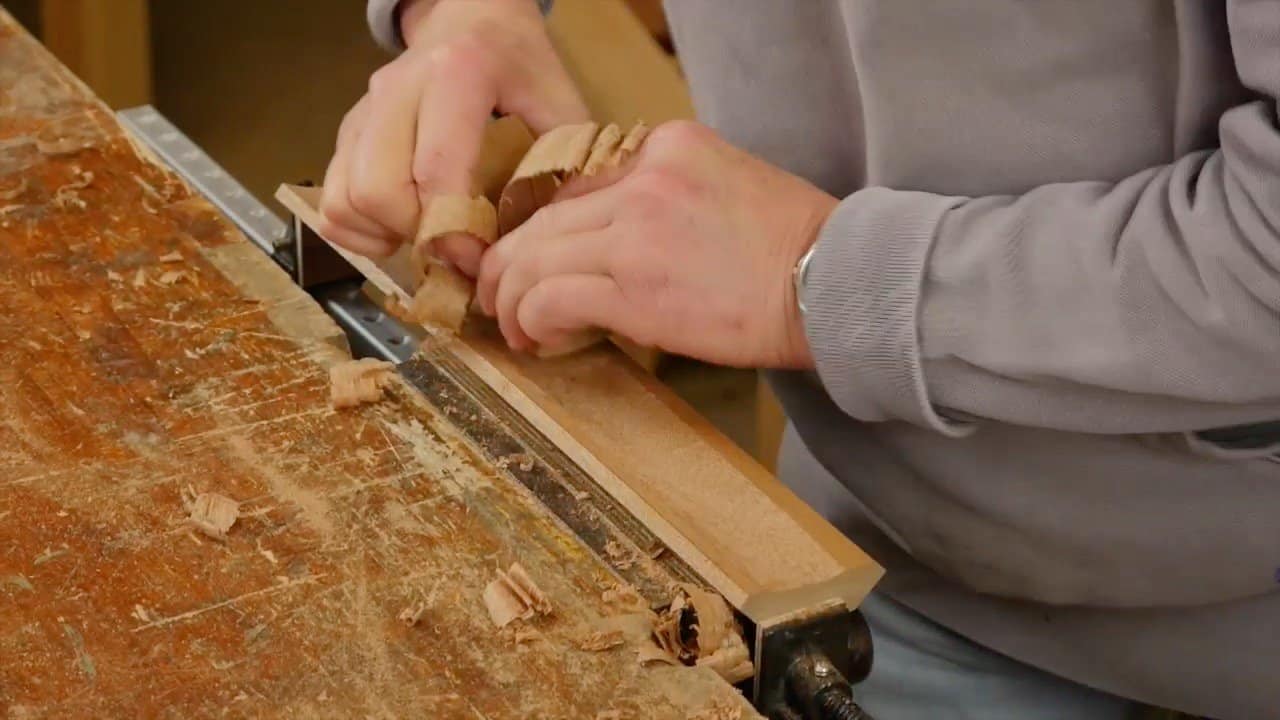Making a Cornice
Posted 25 July 2016
This is an episode in a free series. Want to watch it? It is free to do so, you just need to log into the site, and you can enjoy this video and many other videos we think you will love.
Paul shows how to use hand techniques to make a cornice. This might be just what you need to finish off a project. The first step is a 45° cut on both edges. Then a round bottom plane (as made in this project) is used to scallop the midsection, followed by the scraper and a light sanding.


Wonderful.. Thank You..
Thank you WWMC!
Very useful info here!
I’ve been waiting for this one! I missed seeing it for the ending of the wall cabinet. Very nice.
Thanks for posting this Derek. I would have missed it.
Can you please say where we can find the video on making the little moulding plane you used here. Many thanks, Paul.
It’s in the description but the link doesn’t stand out. Look for “… as made in _this project_”.
I was just about to go out and buy cornice for a project that I am working on, Thanks for the video. I am going to try to make my own.
Thank you Mr. Sellers
Thanks, again, Paul.
This is very timely. Just got several hollows and rounds and wanted to work on mouldings.
Lessons (for me)
1. ‘Angling’ the cut with the planes! To finish to the guide marks?
2. Both ways plane (even Paul made that look like hard work).
The finish is for the eye, not the protractor!
Thanks Paul.
You make it look so easy 🙂
Many thanks for showing how to do this!
Is the scrub plane the only option (rather than ripping) for the 45 degree bevels on a long piece? Ripping horizontally at 45 degrees seems impractical, but you couldn’t stand a 6-footer up in the vise.
Watching your videos and listening to your advice is time well invested. You can’t get this from a text book. Brilliant! Priceless!
Ya wee beauty! I’ve been looking forward to this one!
You have made my day………. again 🙂
paul,
great video and you make it look easy!
Why choose the rocker bottom plane over a larger round moulding plane over some rebates to form the coving? does it matter?
Thanks again for the great video!
@benbeel i think the idea of using this plane is if you don’t have this plane there is a video on here how to make one , and i guess very few of us will have a collection of moulding planes , that’s my take on it but hey I’ve been wrong before
So you wouldnt use a 45 sled to make the moulding and used hollow and rounds to ake to cove
Same question as Benbeel: what about using a moderate size round (but straight soled) plane? I suppose the radius has to be just under what you want to cut? I have a few odd sized hollows and rounds that I have never used for anything yet…. That would be great if you could show us how to use those properly!
Thanks!
Nice job, Paul!
Wondering what is the best joint to join two pieces of cornice on the run?
Would you use a simple 45 deg or would you dowel or spline it or perhaps a double angle or “V” at the joint.
Thanks, JIM
Paul
I have a small selection of hollow and rounds……I made a shoe horn with largest.
Whilst the little plane is a handy tool, do you see a great advantage over a round plane….please
Thank you John 2V
I learned:
(1) “Cornice” and “Crown Molding” are different words for basically the same thing.
(2) This is what “Zada” Polaski did when he used his multiple planes to make a complex molding.
(3) I believe I read the grain correctly when you ran into changing grain on just about every surface right about in the middle of the piece of wood.
(4) What you do with a plane with a sole that is curved both side-to-side and front to back.
Thank you, sir.
It is fascinating to watch an excellent tutorial on hand made cornice.
It would be equally fascinating to watch how to create the round bottom hand plane.
Many thanks for publishing this video, and a superb craftsmanship.
@pheroz try this https://woodworkingmasterclasses.com/2014/01/making-wooden-planes-info/
Thank you for the lesson.
Thank You Paul and team for this one another great video, I never made moldings by hand but will now.
Steve
Wow
Hi Paul thanks for this video, and keeping the process simple, I am thinking of making a tool cabinet the cornice should Finnish it of nicely. Larry.
I can’t see this working for a novice like me.
One wayward slip with that Molding Plane and I’ve got 6 feet of scrap, expensive, hardwood.
Would a rebate (rabbet) on the rear bottom edge give a better fitting to the cabinet and also a bracket to drill & screw from above?